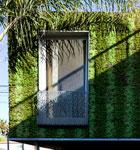Just a few years after Martin Leon established Alisal Builders to serve the Southern California residential market, he got the opportunity of a lifetime: build a green house in Venice. Given that it was the 1990s, it was a unique job, but not as unique as the one that presented itself more than a decade later: renovate the same house to be even more sustainable.
When Leon built the 515-square-foot cottage on spec in 1998, he did so using the most sustainable technologies at the time: passive solar heating and cooling, double-pane windows, and recycled building materials. “In 1998, there weren’t nearly the options we had for the renovation in 2008. What few technologies were available were prohibitively expensive,” Leon says. But when the buyers hired Alisal to do a renovation and addition in 2008, Leon and his team were able to create what he says is the most sustainable house in Venice.
 Exterior
Exterior
The Bricault home’s most dynamic—and visible—element is its living wall by Elevated Landscape Technologies. Covered in draught-resistant native plants, the wall contributes to a solar shading strategy and naturally insulates the home. The steel-frame house with timber frame infill also features exterior cladding made from cedar batten certified by the FSC. Windows and glass block also contribute to the home’s energy efficiency.
Roof
Low-slope roofing consists of a thermoplastic olefin (TPO) white membrane roof installed by Allied Waterproofing, which, in addition to being environmentally friendly, is ozone- and algae-resistant. It is complemented by a green roof and rooftop vegetable garden over part of the home, adding green space and insulating the home. The Venice home also has three rows of solar panels from Acro Energy Technologies, which Leon says reduces eclectic consumption to “almost nothing.”
Irrigation
A rainwater-capture system waters the living wall, while a subsurface irrigation system acts as an aquifer, storing water that the landscaping can draw from. The landscaping, designed by The Great Outdoors Landscape Design & Construction, derives as much as 30 percent of its water from the irrigation system, Leon says.
Interior
The home is designed in a way as to eliminate the need for artificial cooling: when the interior pivot doors are open, air is drawn from the lower level to the upper level, flushing it out without using any electricity. All interior finishes also are green: Formaldehyde-free cabinets made from locally harvested American ash; tile and terrazzo is recycled; and flooring is made from maple, cork, and scrap mosaic tile. Other green interior features include LED lighting and American Clay low-VOC paints.


